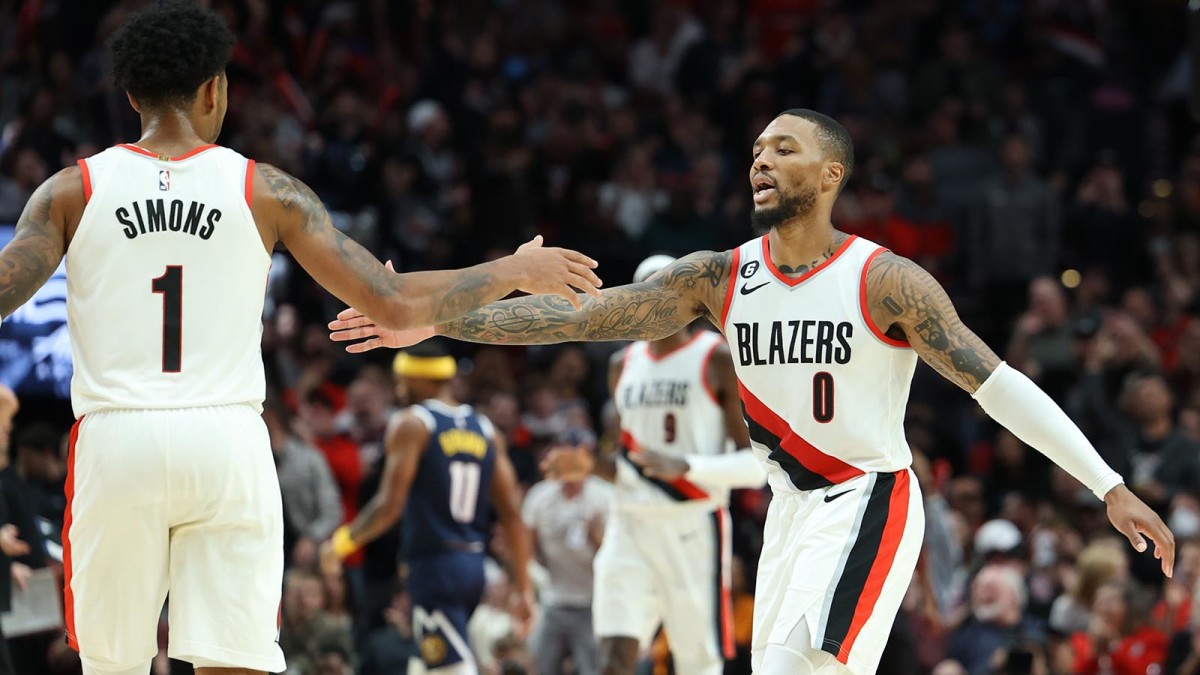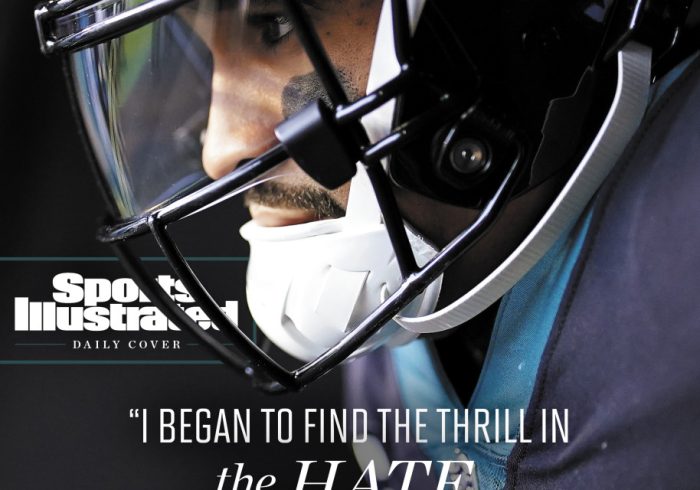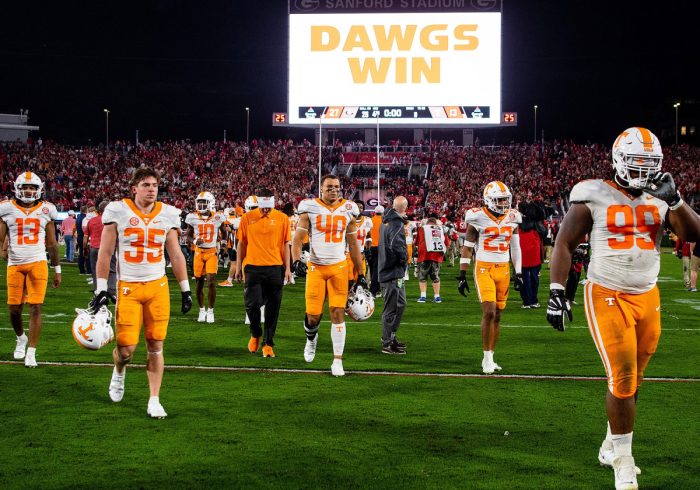It would be more than fair to say much of last year was dismal for the Blazers and their fans.
The details and particulars of the Chauncey Billups hire came into question, and the executive who made the hire—and urged people to trust he’d done all the necessary due diligence into the matter—was then terminated following an independent investigation into the workplace culture he fostered.
There was often a lack of fun on the court, too. Early on, franchise player Damian Lillard looked like a shell of himself while dealing with an abdominal injury that would later require surgery. CJ McCollum, a longtime fan favorite despite the team’s core having been held together for too long, was dealt to New Orleans a couple days before the February trade deadline.
But for how joyless things were in Rip City last season, this campaign has been a different story altogether.
The Blazers became the league’s only 4-0 team Monday, drilling Denver, 135–110, all while featuring six scorers who finished with more points than Nikola Jokić, the reigning two-time MVP.
Lillard finished with a game-high 31 points, but the most electric moments of the contest belonged to 23-year-old Anfernee Simons, who logged a dominant 22-point quarter in the third, hitting six triples in that window to send the Portland crowd into a tizzy.
That’s part of what’s been so fun about the Blazers to this point. Simons, one of the only true bright spots from a dark 2021–22 campaign, had a chance to spread his wings last season. He took advantage, more than doubling his scoring output to 17.3 points per game on better than 40% from deep. It put him in a better position to occasionally lead alongside Lillard. And Lillard—for all he’s accomplished individually as a star—has trusted Simons to take that role.
In the team’s home opener last week, with a tie game against Phoenix and the clock ticking down into single digits, Lillard opted to hand the ball over to Simons. It didn’t matter how many game-winners Lillard had notched throughout his career. It didn’t matter that Simons had Mikal Bridges, a finalist for Defensive Player of the Year last season, guarding him on the perimeter.
The result was Simons penetrating into the lane in overtime and hitting a tough hook shot on Bridges to beat the club that logged the best record in the league last season.
“I told him: I trust you,” Lillard said of the game-winning sequence with Simons. “Put your big boy pants on. You got the big contract. You got the game. You put the work in. We spend a lot of time together. And it comes down to trust. I had it going [against the Suns], and I felt really good tonight. But I told him: I trust you, and I’m gonna look at moments like this and show you that I really trust you—I’m not just saying it. And he came through for us.”
Having Lillard and his leadership back makes a world of difference, as does the fact that the Blazers are getting to the line 25 times per night, 55% more often than they did last season.
Above all else, though, the current roster is far more versatile and disruptive than it was before. Jerami Grant has been a fantastic fit on both ends. The oft-injured Justise Winslow has undoubtedly been a boon for the defense. And Josh Hart, who came over in the McCollum deal and has long been one of the league’s best transition players, jumpstarts the team in the open floor. (He’s also averaging 10.3 rebounds per game while standing just 6’ 5”.) None of this even touches on offseason pickup Gary Payton II yet, as he’s on the mend from an injury to his core.
We’re even seeing glimpses of exactly what made Shaedon Sharpe, the No. 7 overall pick, such an intriguing gamble for this team to take. The athleticism is there. The range was on display Monday night. He makes good use of ball fakes and has incredible body control in traffic. Billups trusted Sharpe enough to make him the first player off the bench in the win over Denver.
It’s too soon to know what all of this means. But the Blazers are armed with talent on both sides of the ball, and if they stay healthy, they’ll be both highly entertaining and intriguing as we head into April and May.
Meat and potatoes: Good reads from SI this past week
- Chris Mannix has you covered with respect to the reigning Eastern Conference champion Celtics. He penned today’s Daily Cover feature: an exclusive sitdown with Boston’s interim coach Joe Mazzulla, who opened up not only about his checkered past, but the moments in his life that ultimately led up to this one.
Stray thoughts on the Mavs
Luka Doncic and the Mavs are playing at a faster tempo than last season.
Kevin Jairaj/USA TODAY Sports
One of my biggest concerns coming into this season was about Luka Dončić.
That concern had very little to do with the perennial MVP candidate’s ability, and more to do with the roster around him; one that lost second-leading scorer Jalen Brunson for nothing during the offseason. What would Brunson’s departure mean for Dončić, who already had the NBA’s highest usage rate among guards last season? Will it be too heavy a load to carry at times?
It’s obviously a bit early to answer that question. But in watching the Mavs so far, they’ve provided some interesting counters to that initial thought.
Dončić is still up to his heliocentric ways, and as of Tuesday morning led the league lead in usage, with about 39% of Dallas’s possessions ending with either a Dončić shot or turnover. Yet the Mavs playing with a faster tempo could shorten many of those possessions, making for far less grinding work in the process.
The Mavericks, dead last in pace last season as a result of Dončić’s slow, rock-the-defender-to-sleep tendencies, currently rank 24th. Still below average, and still slow, but still noticeably quicker than a year ago. Some of that seems orchestrated and by design.
Christian Wood, the team’s biggest offseason acquisition and its second-leading scorer, said Dončic told him during the team’s win over the Grizzlies to just run down the floor hard and to possess the dunker spot on the floor, and that Dončić would get him a lob pass during an upcoming possession. Shortly after that, Dončić blocked a shot, pushed the ball in transition and then did precisely that, leading to a Wood dunk on the break.
That sequence—Dallas getting a stop, then immediately pushing the tempo—has yielded great things for the Mavs thus far. They’ve averaged 1.41 points per possession after forcing misses on defense, the highest rate in the league by a mile, according to Inpredictable, an analytical site that breaks down data by possession type.
Perhaps even more promising than the transition opportunities is the Dončić-Wood partnership. The duo has logged only 31 minutes together so far, as Wood has come off the bench to this point. But even in that role, Wood has thrived, averaging 25 points through the first two games, while the Mavs have put up a whopping 147.6 points per 100 possessions in Dončić and Wood’s time together.
So maybe the questions about Dončić’s workload were overblown. If the defense can perform the way it has while getting anywhere near this much out of Wood as a second scorer, the Mavs will be a threat to get back to the Western Conference finals, or perhaps even beyond that.
A new low in Lakerland
We didn’t have the highest hopes for the Lakers this season, but wow, their first week was even more of a struggle than we thought was possible for them.
Through three games, all of which were losses, Los Angeles is connecting on an abysmal 21.2% of its three-point attempts—a number so poor that it forces you to do a double take. Yes, we said the Lakers are shooting just 21.2% from deep.
To put that in perspective, even the worst three-point shooter of all time, Charles Barkley, hit a higher share of his attempts (26.6%) over his career. And of course that was during the 1980s and 1990s, when three-point shooters tried their hand far less—and were far less accurate—than players are nowadays. These Lakers are taking 39 threes per game, making just eight of them on average.
If the Lakers were to keep this up, it would be borderline historic. You have to go back more than three decades, to the 1990–91 Washington Bullets, to find the last time a club shot worse than this from outside. If you want to go back even farther to unveil the worst three-point shooting club in NBA history, interestingly enough you’d again land on the Lakers, who reached the NBA Finals in 1983 despite connecting on just 10.4%—10 of 96—of their threes that season.
The shame of it all: So far, the Lakers have been really good on defense, ranking second in the NBA. They turn opponents over at the highest rate in the league and play at an uptempo pace that last year’s at-times-geriatric group only could have dreamt of. But despite that, and despite having two of the world’s 20 best players to lead the way on offense, we’re talking about an 0–3 start. Los Angeles has an offense that ranks second-to-last because of an inability to hit the longball and an issue—the constant questions about Russell Westbrook’s poor fit—that won’t go away until the Lakers end this circus once and for all by making a trade they had all offseason to make.
I’m declaring now that I won’t write about this team again until they do something—either win, have someone break an all-time record for scoring or make a trade worth analyzing—that’s truly deserving of the space. It’s all gotten far too silly considering we’re only one week in.
Some love for the rookies
Rookie Paolo Banchero has joined elite company after scoring 20 or more points in each of his first four games.
Kim Klement/USA TODAY Sports
It’s so tempting for some to look ahead to next year’s lottery. But it couldn’t be clearer that there’s ample value in watching the Magic, Pacers and Pistons, among others, because of the youngsters they already have on the roster.
- Orlando’s Paolo Banchero finds himself in elite company after having smoothly notched 20 points in each of his first four games—an enormous bright spot given that the Magic have started 0–4. What stands out about him is what often stood out about LeBron: he creates so many of his own opportunities—and so many for his teammates—despite being the new kid on the block. And that’s highly unusual. His comfort level jumps off the screen from night to night. At just 3-for-16 from three, Banchero has struggled from deep. But if and when he gets more consistent from there, it’ll be even more of a conundrum for defenses as to how to defend him.
- Keegan Murray has been a total natural in Sacramento. His first NBA basket, a triple, came off a pass that wasn’t even intended for him. He consistently manages to find soft spots in the defense and, much like someone like teammate Harrison Barnes, looks like the sort of player who would fit with any team. Don’t get it twisted, though: it wouldn’t be a surprise at all if the guy becomes a star as opposed to someone who merely fits in. He logged 19 points in his debut, then followed it up with 16 in his second outing.
- We certainly can’t leave out Jaden Ivey, who’s been fantastic for Detroit thus far. What stands out about him is that he looks really comfortable playing alongside Cade Cunningham, but also seems at ease when he has to make something happen for someone else. His first regular-season basket as a pro stemmed from an intuitive cut he made after a Cunningham drive. He’s logging six assists per game to go with the 17.6 points he averages on 50% shooting, fantastic efficiency for a rookie guard.
A little love for the Jazz, too
The Jazz are off to a surprising start after trading away Rudy Gobert and Donovan Mitchell.
Thomas Shea/USA TODAY Sports
Utah’s fourth-quarter luck ran out Monday night during a loss to the lowly, bickering Rockets.
But I thought it’d be worth it to spotlight the Jazz, who have no scheduled national TV games this season after having dealt away Donovan Mitchell and Rudy Gobert to kickstart a rebuild.
Simply put: Utah has been unexpectedly fun thus far. Many of us, myself included, saw the Jazz shipping out their stars and immediately figured the losses would pile up like crazy. (And they probably will at some point.) At the same time, though, this isn’t necessarily a young team.
Mike Conley and Jordan Clarkson comprise the starting backcourt. Jarred Vanderbilt, Lauri Markkanen and Kelly Olynyk make up the starting frontcourt. Malik Beasley, Collin Sexton, Talen Horton-Tucker and Rudy Gay are among the biggest minute-getters off the bench.
At times, you see why some fans and analysts alike were blown away by how much Minnesota gave up to get Gobert, as the hard-nosed Vanderbilt and Beasley are solid veterans who would benefit most teams. (In addition to those two and the never-ending list of picks, Utah also got Beverley for Gobert before trading the guard to the Lakers for Horton-Tucker.) You also can see why Danny Ainge was seeking to trade away other pieces—and probably still will seek to trade some pieces—as the Jazz still have enough to win with, even after dealing away four starters.
Utah has been good in a number of categories since play opened last week. Second in offensive rebound rate. Third at forcing turnovers on defense. Fifth in assist percentage. Seventh in three-pointers made, and 11th in three-point percentage, all while holding opponents to the fourth-lowest three-point percentage.
The 25-year-old Markkanen has led Utah in scoring at 21.5 points per night, and his activity has been noteworthy. At 24%, the 7-foot forward hasn’t shot it well from deep. But he’s repeatedly found crevices in the defense and hurt teams with backcuts left and right, particularly when Clarkson’s running the offense and looking for dump-off passes to make. (As a starter, and with Conley aging, Clarkson has had the ball in his hands more than ever. He’s logging the highest assist percentage of his career while also holding the highest turnover rate of his career.)
The bench unit has been highly entertaining at times, even prompting a brief, if-you-squint-your-eyes-real-hard comparison made by the Jazz broadcast crew about Sexton and rookie big man Walker Kessler having some of the same traits that Mitchell and Gobert had.
It’s easy to see the team’s biggest flaw: Opponents are having their way with the Jazz at the rim and on the defensive glass. (Shockingly, for all the things Olynyk can do, he isn’t exactly Gobert in terms of rim protection.) Utah is giving up a league-high 62 points per game at the cup to this point and ranks second-to-last in defensive rebound percentage. Those struggles, combined with the fact that teams will surely shoot better than 29.9% from three against the Jazz going forward, give reason to think that results will go the other way in the coming weeks.
Still, no one—not even the Jazz—was expecting a 3–0 start from the Jazz. And it was certainly fun to watch, given what the expectations were.
More NBA Coverage:



